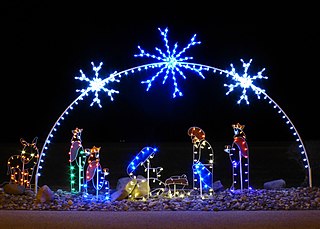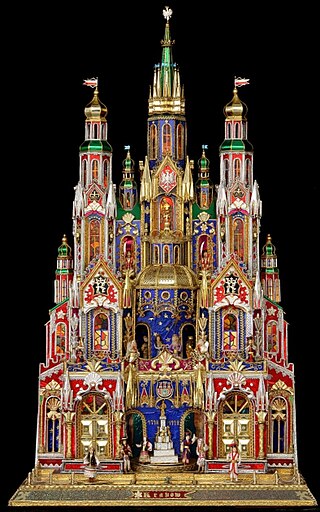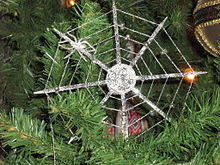
Christmas is an annual festival commemorating the birth of Jesus Christ, observed primarily on December 25 as a religious and cultural celebration among billions of people around the world. A feast central to the liturgical year in Christianity, it follows the season of Advent or the Nativity Fast, and initiates the season of Christmastide, which historically in the West lasts twelve days and culminates on Twelfth Night. Christmas Day is a public holiday in many countries, is celebrated religiously by a majority of Christians, as well as culturally by many non-Christians, and forms an integral part of the holiday season surrounding it.

Christmas in Poland is a major annual celebration, as in most countries of the Christian world. The observance of Christmas developed gradually over the centuries, beginning in ancient times; combining old Polish pagan customs with the religious ones introduced after the Christianization of Poland by the Catholic Church. Later influences include the mutual permeating of local traditions and various folk cultures. It is one of the most important religious holidays for Poles, who follow a somewhat strict traditional custom. Christmas trees are decorated and lit in family rooms on the day of Christmas Eve. Other trees are placed in most public areas and outside churches. Christmas in Poland is called "Boże Narodzenie", which translates to 'God's Birth'.

A Christmas tree is a decorated tree, usually an evergreen conifer, such as a spruce, pine or fir, or an artificial tree of similar appearance, associated with the celebration of Christmas.

Mary Pope Osborne is an American author of children's books and audiobook narrator. She is best known as the author of the Magic Tree House series, which as of 2017 sold more than 134 million copies worldwide. Both the series and Osborne have won awards, including for Osborne's charitable efforts at promoting children's literacy. One of four children, Osborne moved around in her childhood before attending the University of North Carolina. Following college, Osborne traveled before moving to New York City. She somewhat spontaneously began to write, and her first book was published in 1982. She went on to write a variety of other children's and young adult books before starting the Magic Tree House series in 1992. Osborne's sister Natalie Pope Boyce has written several compendium books to the Magic Tree House series, sometimes with Osborne's husband Will.

Saint Nicholas Day, also called the Feast of Saint Nicholas, observed on 5 or 6 December in Western Christian countries, and on 19 December in Eastern Christian countries using the old church Calendar, is the feast day of Saint Nicholas of Myra; it falls within the season of Advent. It is celebrated as a Christian festival with particular regard to Saint Nicholas' reputation as a bringer of gifts, as well as through the attendance of church services.

Christmas ornaments, baubles, globes, "Christmas bulbs", or "Christmas bubbles" are decoration items, usually to decorate Christmas trees. These decorations may be woven, blown, molded, carved from wood or expanded polystyrene, or made by other techniques.

The observance of Christmas around the world varies by country. The day of Christmas, and in some cases the day before and the day after, are recognized by many national governments and cultures worldwide, including in areas where Christianity is a minority religion. In some non-Christian areas, periods of former colonial rule introduced the celebration ; in others, Christian minorities or foreign cultural influences have led populations to observe the holiday.

Tinsel is a type of decorative material that mimics the effect of ice, consisting of thin strips of sparkling material attached to a thread. When in long narrow strips not attached to thread, it is called "lametta", and emulates icicles. It was originally a metallic garland for Christmas decoration. The modern production of tinsel typically involves plastic, and is used particularly to decorate Christmas trees. It may be hung from ceilings or wrapped around statues, lampposts, and so on. Modern tinsel was invented in Nuremberg, Germany, in 1610, and was originally made of shredded silver.

A Christmas decoration is any of several types of ornamentation used at Christmastide and the greater holiday season. The traditional colors of Christmas are pine green (evergreen), snow white, and heart red. Gold and silver are also prevalent, as are other metallic colours. Typical images on Christmas decorations include Baby Jesus, Mother Mary, angels, Father Christmas, Santa Claus, and the star of Bethlehem. Advent wreaths, nativity scenes, illuminations, and Moravian stars are popular Christmas decorations.

Snegurochka (diminutive) or Snegurka, or The Snow Maiden, is a character in Russian fairy tales.

The Christmas pickle is an American Christmas tradition. A decoration in the shape of a pickle is hidden on a Christmas tree, with the finder receiving either a reward or good fortune for the next year. There are a number of different origin stories attributed to the tradition, including one originating in Germany. This theory has since been discounted, and it is now thought to be a German-American tradition created in the late 19th century. In fact, the New York Times reported that out of 2,057 Germans polled, YouGov determined 91% were unaware of the legend.

Throughout history, spiders have been depicted in popular culture, mythology and in symbolism. From Greek mythology to African folklore, the spider has been used to represent a variety of things, and endures into the present day with characters such as Shelob from The Lord of the Rings and Spider-Man from the eponymous comic series. It is also a symbol of mischief and malice for its toxic venom and the slow death it causes, which is often seen as a curse. In addition, the spider has inspired creations from an ancient geoglyph to a modern steampunk spectacle. Spiders have been the focus of fears, stories and mythologies of various cultures for centuries.

Santa Claus, also known as Father Christmas, Saint Nicholas, Saint Nick, Kris Kringle, or simply Santa, is a legendary figure originating in Western Christian culture who is said to bring gifts during the late evening and overnight hours on Christmas Eve. He is said to accomplish this with the aid of Christmas elves, who make the toys in his North Pole workshop, and with the aid of flying reindeer who pull his sleigh through the air.
Le Jongleur de Notre Dame is a religious miracle story by the French author Anatole France, first printed in a newspaper in 1890, and published in a short story collection in 1892. It is based on an old medieval legend, similar to the later Christmas carol The Little Drummer Boy.
The Boar's Head Feast is a festival of the Christmas season.

Saint Nicholas is a legendary figure in European folklore based on the Greek early Christian bishop Nicholas of Myra, patron saint of children.

In Ukraine, Christmas celebrations traditionally start on Christmas Eve, which is celebrated from December 24 to January 6, the date of the celebration of the baptism of Jesus, known in Ukraine as Vodokhreshche or Yordan, according to the Gregorian calendar and Revised Julian calendar by the Orthodox Church of Ukraine (OCU), the Catholic Church in Ukraine, and most Ukrainian Protestants.

Christmas traditions in Australia, like Christmas in New Zealand, have many similarities to British, Irish, American and Canadian traditions, including traditional Christmas symbols featuring winter iconography. This means a red fur-coated Father Christmas or Santa Claus riding a sleigh, songs such as "Jingle Bells", and various Christmas scenes on Christmas cards and decorations. However, the timing of Christmas occurring during the Southern Hemisphere's summer season has resulted in the development of some local traditions as a result of the warmer weather.

Christmas traditions include a variety of customs, religious practices, rituals, and folklore associated with the celebration of Christmas. Many of these traditions vary by country or region, while others are practiced virtually identically worldwide.

The I-17 Mystery Christmas tree is a living tree in the median of Interstate 17 (I-17) in the US state of Arizona that was decorated each Christmas by people not publicly known. The tree is located near milepost 254, approximately 55 miles (89 km) north of downtown Phoenix, Arizona, between Sunset Point and Cordes Junction.


















